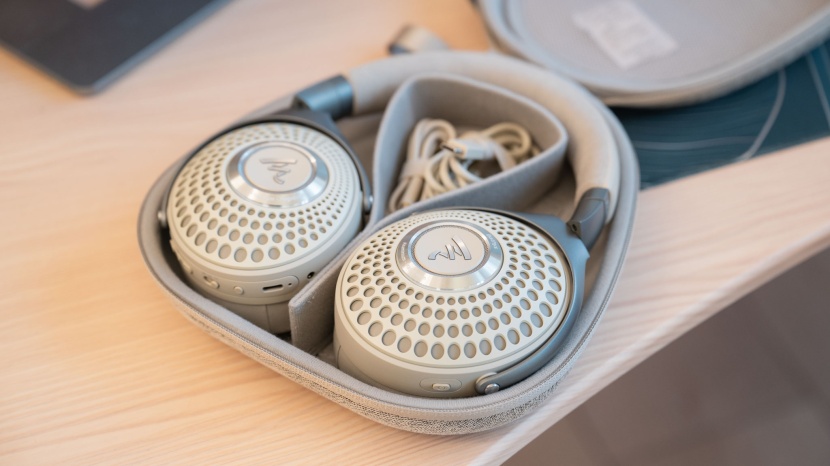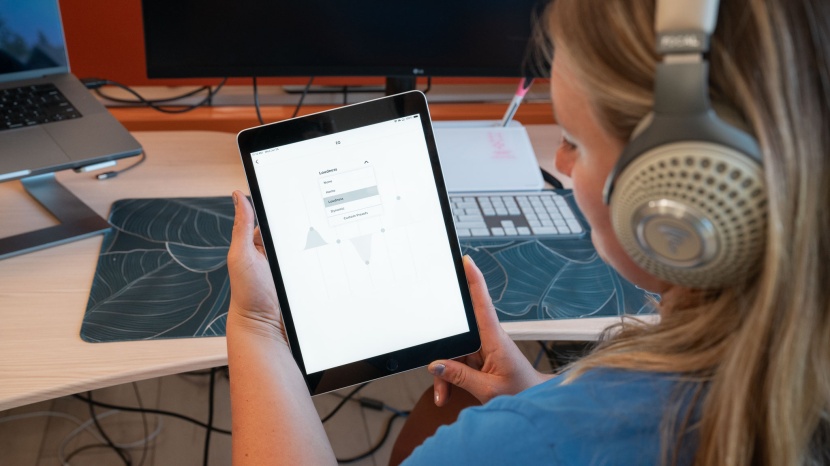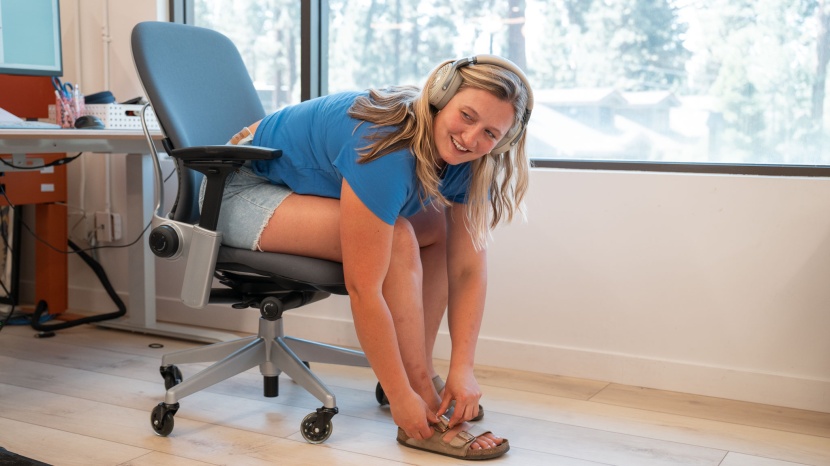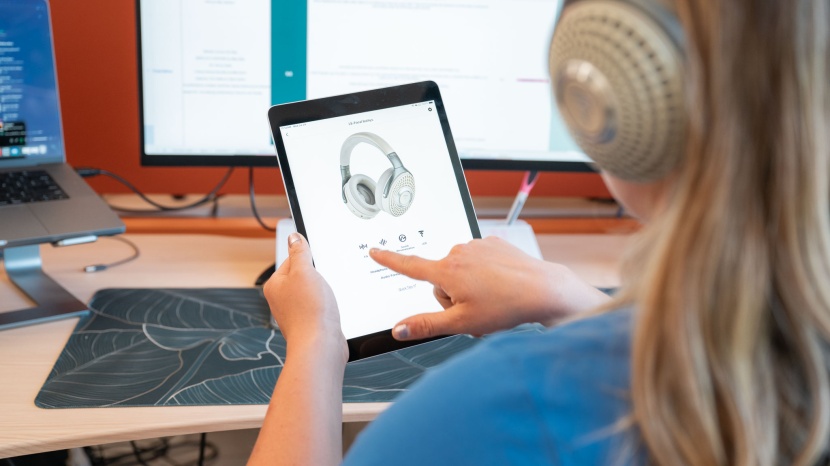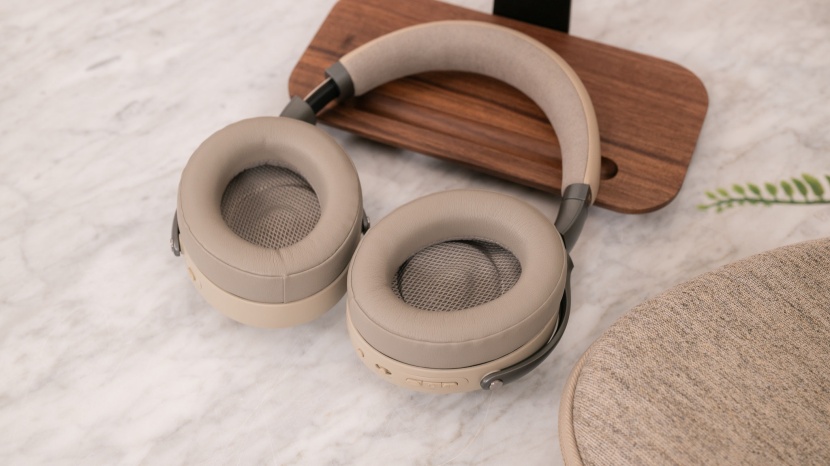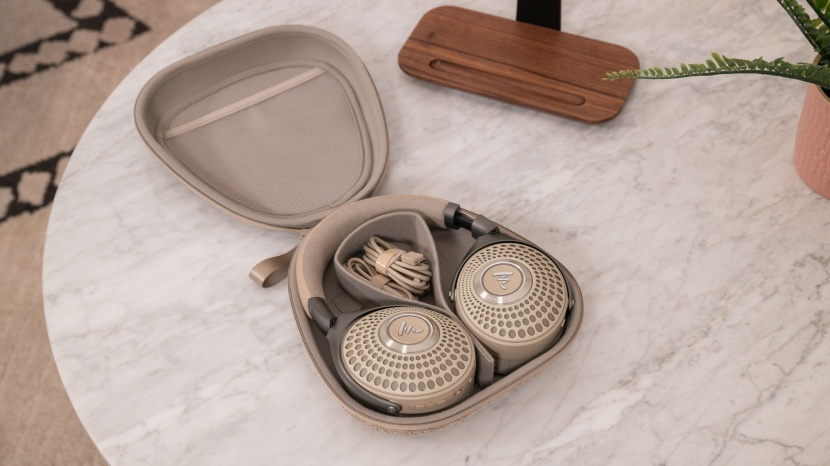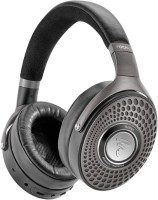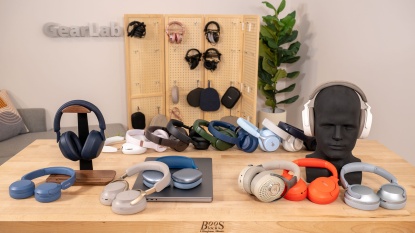
Our Verdict
Our Analysis and Test Results
Our Focal Bathys Headphones Experience
The Focal Bathys look cool. No doubt about it, they are unique with a fit and finish that proclaims something special is located inside. The outer earcup features a textured finish of concentric circles that resemble a honeycomb, albeit without the hexagonal shape. They look somehow old-school and futuristic at the same time, and passersby often notice and sometimes stare. They are not the headset for those looking to blend in, but rather to stand out.
This headset pairs well with both Android and Apple devices, but the multipoint feature works best when paired with devices of the same operating system, such as an iPhone and a Mac. We had trouble pairing two devices with different operating systems, like an iPhone and an Android phone. While not a deal breaker, we think it's noteworthy for some users. Pairing with a single device was no big deal.
While not the best user interface, the Focal Bathys have responsive, easy-to-use physical controls and an in-app adjustable EQ. The headphones announce modes, so we didn't have to guess, which was a welcome bonus feature. They come with a carry case and the necessary cords to charge and listen, using an audio cable.
The Focals are among the heaviest in the group, weighing 359 grams, which is almost a hundred grams more than most competitors. We thought they felt comfy with glasses, and the cups are spacious with a soft but effective clamping force. However, the mind-blowing sound wasn't enough to override the eventual discomfort of the weight pressing on the headband and the top of our ears after wearing them for a few hours. We even wondered if we had them on right, it was so bad. Some testers eventually passed them by for more comfortable options, even though we all universally agreed they had the best sound.
Sound Quality
The Focal Bathys' sound quality is on another level. While most consumers won't appreciate the full value, the Focal Bathys are a revelation for some. They have a natural and unsculpted sound profile, with exciting and expressive details across the frequency spectrum. No range overpowers another, no matter the song or genre. The lows have punch and power, the mids have depth and presence, and the highs have titillating sparkles. No matter where we set the volume level, the Bathys maintained rich texture.
The low-end reproduction is fantastic. They pack a punch when it's called for, but without sounding disproportionately boomy or blown out. This is worth lingering on. Engineering headphones and earbuds to make noise at low-end frequencies is relatively easy. That's why even the cheapest pair of wired earbuds can thud and thump along to the average pop song. It's challenging to engineer headphones to produce a fun and present low-end that's also richly detailed and nuanced. Most consumers don't realize what they're missing; the low-end mix has much more going on than we typically hear. The Bathys unlock this sonic space, allowing listeners to discern the texture of every rumble instead of just feeling boomy bass thrown at their ears. Listeners of every genre can appreciate what these headphones reveal.
The reproduction of these headphones in the midrange is accurate. They relay what the producer intended for you to hear. They effortlessly maintain this feeling of accuracy as they glide through a wide range of genres. Songs like “Sailing” by Rod Stewart have an exceptionally warm and deep guitar tone that contrasts against Stewart's iconic rasp. At 2:42 in the song “Locals” by Willis, the synth joins the drums, vocals, and guitar. With many instruments competing for midrange space, it never loses any clarity or presence.
Though the highs are exceptional compared to most other headphones, they're not quite as impactful as the Bathys own low-end and midrange performance. They're not bad; quite the opposite, they just aren't as mind-blowing. The highs extend the reach of the Bathys' detail and texture to the top of the frequency spectrum. Miles Davis' trumpet in “It Never Entered My Mind” is a great example of how an instrument with a huge range can feel unlocked, as if the texture in the room with a master trumpeter is accurately expressed to the listener. The only drawback is that treble-only music (which is uncommon) won't have the same impact as songs that span the entire frequency range. So, if you're the rare listener who only listens to high-frequency music, you'll miss most of what these headphones offer.
Overall, the Bathys offer a special listening experience. While many high-end headphones in our lineup sounded great, none had quite the level of accuracy and detail present throughout the entire sound profile. While some headphones might specialize in lows, mids, and highs, these offer an exhilarating synthesis of each range, allowing listeners of any genre to unveil the details often hidden from their ears.
We compared the frequency response curve of these headphones to our custom GearLab House Curve to get a baseline against what we think is the ideal consumer curve.
The results validate our findings; these headphones produce sound where we think they should. Bass (0Hz to 500Hz) rolls in a little more slowly than our curve, but is at our expected gain level once it arrives, while the mids and highs are very close to our curve.
These headphones produce sound at an appropriate level across the frequency spectrum, in a way that most consumers will appreciate. Ultimately, listeners of any genre, aside from perhaps the most devoted sub-bass EDM enthusiasts, will enjoy the Bathys.
Soundstage
An essential part of live music is the sensation of being enveloped by sound, with each instrument occupying a distinct position in space. Soundstage brings a sense of space and dimension to music. Achieving this is still challenging and rare.
The Bathys manage to pull off a wider and more expansive sound than the competition. The soundstage is so good that songs that have been mixed with heavy panning (pushing instruments to one side or another during the recording and mixing process), like “Love Theme (Version 2)” by Piero Piccioni, can feel almost uncomfortably unbalanced. This is more of a pro than a con, as the soundstage is so good that it places instruments exactly where the producer placed them. The expansiveness here is unparalleled, and listeners of any genre will appreciate experiencing the music's spatiality as it was intended.
Comfort and Fit
The Bathys aren't the most comfortable, thanks in part to their 359-gram weight. They have spacious 61mm by 47mm ear cups and ample ear space. However, the headband pressure built over time, and we only lasted about three hours.
While head tilting front to back wasn't a problem, side-to-side motion or aggressive headbanging resulted in them falling.
Noise Cancellation
The Bathys noise cancellation is a bit disappointing.
During our passive cancellation tests (ANC off), several noises leak through across the frequency spectrum. Most notably, the bass gets passed relatively easily, so you'll need to have ANC on to get the most benefit.
Surprisingly, there's not a significant improvement using ANC. Bass reduction stays about the same, while mids are reduced slightly more than passive, and treble is more significantly reduced. This means that the high-pitched hum and hiss of fans are diminished, but voices and low-frequency thuds and rumbles can still be heard. We wouldn't recommend them for things like airplane or subway travel.
App and Controls
The Bathys app has four built-in EQ presets to accentuate different parts of the frequency spectrum. They feel responsive and never detract from the listening experience. However, we wish there were more presets or fine-grained tunability. Their Dynamic EQ setting aligns with what most consumers expect: a pronounced bass that dominates the mix.
The Bathys come with a proprietary in-cable Digital to Analog Converter (DAC). They claim it allows lossless audio playback at 44bits by 196kHz. All modern phones, tablets, and computers have a stock, built-in DAC. This converts digital audio into the electrical signals required for devices to make noise. Most USB-C headphone connections rely on built-in device DACs. This is typically sufficient, but lossless compression is limited to the capabilities of the built-in DACs. Focal controls the DAC engineering by bypassing the built-in and using the DAC they designed in their cable. The company claims audio playback at much higher bit rates. This nuance is nearly impossible to test; only a small percentage will hear marginal differences in the bitrate. To the average listener, it isn't all that useful.
Connectivity
The Bathys have multipoint connectivity, but they struggled when connected to one Apple and one Android device simultaneously. This was especially pronounced when using the app. When connected to two devices of the same family, they performed well, seamlessly switching between sources.
Battery Life
The Focal Bathys have a middle-of-the-road battery that provides 27 hours of Bluetooth playback, which is slightly lower than the manufacturer's claimed 30 hours.
Their runtime is average compared to other top performers. Still, 27 hours will likely please most listeners, and in our experience, they aren't comfortable enough for all-day listening anyway.
Call Quality
The Focal Bathys struggled with call quality compared to the competition. They are below average, but more disappointing because, for the price, it almost feels offensive. Ultimately, you should expect to make calls in a quiet room with few distractions.
In an office, calls relay okay, but most of the background sounds linger. The murmurs of the office workers are distracting when the caller pauses. The baseline call quality is muffled. It's almost as if a white noise hum was added.
During our subway test, the call was audible, but with an echo. The hustle and bustle of the loudspeaker and rails weren't silenced, creating word confusion.
| Awards | Best Sound for Audiophiles |
|---|---|
| Price | $699 List Check Amazon (on sale!) |
Overall Score  |
|
| Star Rating | |
| Bottom Line | Audiophiles will love these headphones, but they are expensive, offer poor noise cancellation, and aren't the most comfortable |
| Pros | Great audio, premium materials, integrated USB-C DAC |
| Cons | Poor noise-cancellation, not comfortable, expensive, subpar app |
| Rating Categories | Focal Bathys |
| Sound Quality (35%) | |
| Comfort (25%) | |
| Noise Cancellation (20%) | |
| App & Controls (10%) | |
| Call Quality (10%) | |
| Specifications | Focal Bathys |
| Comfortable Listening Hours | 4.0 hrs |
| Claimed Battery Life | 30 hrs |
| Wearing Detection | No |
| Multipoint | Yes |
| Measured Weight | 359 g |
| Measured Maximum Connectivity Distance | 106 ft |
| Measured Ear Cup Size | 61 mm H x 47 mm W |
| EQ Customization | Yes |
| Driver Size | 40 mm |
| Passive Playback | No |
| Spatial Audio | No |
| Active Noise Cancelling | Yes |
| Transparent Mode | Yes |
| Connectivity Options | AAC, aptX, aptX Adaptive, SBC |
| Carrying Case | Case |
| Included Cords | -USB-C to USB-C cable -3.5mm to 3.5mm audio cable |



